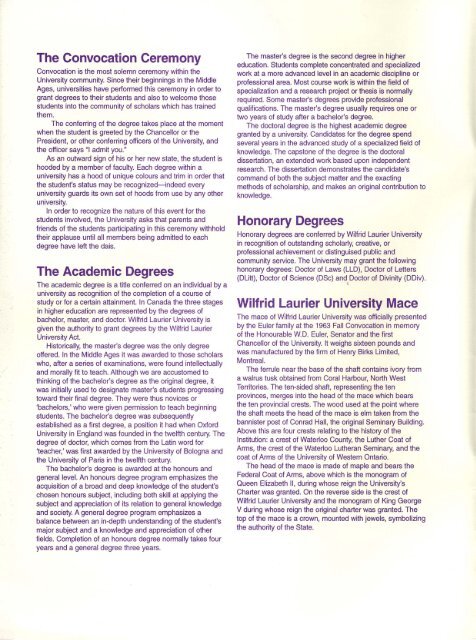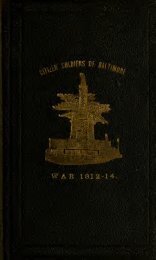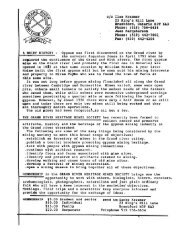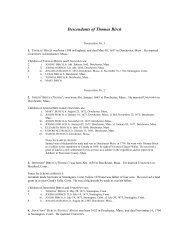Download June 5 1998 convocation program (PDF) - OurOntario.ca
Download June 5 1998 convocation program (PDF) - OurOntario.ca
Download June 5 1998 convocation program (PDF) - OurOntario.ca
Create successful ePaper yourself
Turn your PDF publications into a flip-book with our unique Google optimized e-Paper software.
The Convo<strong>ca</strong>tion Ceremony<br />
Convo<strong>ca</strong>tion is the most solemn ceremony within the<br />
University community. Since their beginnings in the Middle<br />
Ages, universities have performed this ceremony in order to<br />
grant degrees to their students and also to welcome those<br />
students into the community of scholars which has trained<br />
them.<br />
The conferring of the degree takes place at the moment<br />
when the student is greeted by the Chancellor or the<br />
President, or other conferring officers of the University, and<br />
the officer says "I admit you."<br />
As an outward sign of his or her new state, the student is<br />
hooded by a member of faculty. Each degree within a<br />
university has a hood of unique colours and trim in order that<br />
the student's status may be recognized-indeed every<br />
university guards its own set of hoods from use by any other<br />
university.<br />
In order to recognize the nature of this event for the<br />
students involved, the University asks that parents and<br />
friends of the students participating in this ceremony withhold<br />
their applause until all members being admitted to each<br />
degree have left the dais.<br />
The A<strong>ca</strong>demic Degrees<br />
The a<strong>ca</strong>demic degree is a title conferred on an individual by a<br />
university as recognition of the completion of a course of<br />
study or for a certain attainment. In Canada the three stages<br />
in higher edu<strong>ca</strong>tion are represented by the degrees of<br />
bachelor, master, and doctor. Wilfrid Laurier University is<br />
given the authority to grant degrees by the Wilfrid Laurier<br />
University Act.<br />
Histori<strong>ca</strong>lly, the master's degree was the only degree<br />
offered. In the Middle Ages it was awarded to those scholars<br />
who, after a series of examinations, were found intellectually<br />
and morally fit to teach. Although we are accustomed to<br />
thinking of the bachelor's degree as the original degree, it<br />
was initially used to designate master's students progressing<br />
toward their final degree. They were thus novices or<br />
'bachelors,' who were given permission to teach beginning<br />
students. The bachelor's degree was subsequently<br />
established as a first degree, a position it had when Oxford<br />
University in England was founded in the twelfth century. The<br />
degree of doctor, which comes from the Latin word for<br />
'teacher,' was first awarded by the University of Bologna and<br />
the University of Paris in the twelfth century.<br />
The bachelor's degree is awarded at the honours and<br />
general level. An honours degree <strong>program</strong> emphasizes the<br />
acquisition of a broad and deep knowledge of the student's<br />
chosen honours subject, including both skill at applying the<br />
subject and appreciation of its relation to general knowledge<br />
and society. A general degree <strong>program</strong> emphasizes a<br />
balance between an in-depth understanding of the student's<br />
major subject and a knowledge and appreciation of other<br />
fields. Completion of an honours degree normally takes four<br />
years and a general degree three years.<br />
The master's degree is the second degree in higher<br />
edu<strong>ca</strong>tion. Students complete concentrated and specialized<br />
work at a more advanced level in an a<strong>ca</strong>demic discipline or<br />
professional area. Most course work is within the field of<br />
specialization and a research project or thesis is normally<br />
required. Some master's degrees provide professional<br />
qualifi<strong>ca</strong>tions. The master's degree usually requires one or<br />
two years of study after a bachelor's degree.<br />
The doctoral degree is the highest a<strong>ca</strong>demic degree<br />
granted by a university. Candidates for the degree spend<br />
several years in the advanced study of a specialized field of<br />
knowledge. The <strong>ca</strong>pstone of the degree is the doctoral<br />
dissertation, an extended work based upon independent<br />
research. The dissertation demonstrates the <strong>ca</strong>ndidate's<br />
command of both the subject matter and the exacting<br />
methods of scholarship, and makes an original contribution to<br />
knowledge.<br />
Honorary Degrees<br />
Honorary degrees are conferred by Wilfrid Laurier University<br />
in recognition of outstanding scholarly, creative, or<br />
professional achievement or distinguised public and<br />
community service. The University may grant the following<br />
honorary degrees: Doctor of Laws (LLD), Doctor of Letters<br />
(DLitt), Doctor of Science (DSc) and Doctor of Divinity (DDiv).<br />
"<br />
Wilfrid Laurier University Mace<br />
The mace of Wilfrid Laurier University was officially presented<br />
by the Euler family at the 1963 Fall Convo<strong>ca</strong>tion in memory<br />
of the Honourable WD. Euler, Senator and the first<br />
Chancellor of the University. It weighs sixteen pounds and<br />
was manufactured by the firm of Henry Birks Limited,<br />
Montreal.<br />
The ferrule near the base of the shaft contains ivory from<br />
a walrus tusk obtained from Coral Harbour, North West<br />
Territories. The ten-sided shaft, representing the ten<br />
provinces, merges into the head of the mace which bears<br />
the ten provincial crests. The wood used at the point where<br />
the shaft meets the head of the mace is elm taken from the<br />
bannister post of Conrad Hall, the original Seminary Building.<br />
Above this are four crests relating to the history of the<br />
Institution: a crest of Waterloo County, the Luther Coat of<br />
Arms, the crest of the Waterloo Lutheran Seminary, and the<br />
coat of Arms of the University of Western Ontario.<br />
The head of the mace is made of maple and bears the<br />
Federal Coat of Arms, above which is the monogram of<br />
Queen Elizabeth II, during whose reign the University's<br />
Charter was granted. On the reverse side is the crest of<br />
Wilfrid Laurier University and the monogram of King George<br />
V during whose reign the original charter was granted. The<br />
top of the mace is a crown, mounted with jewels, symbolizing<br />
the authority of the State.






